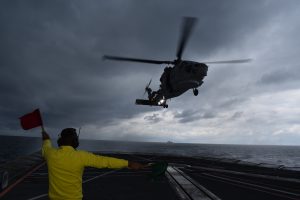India and Japan held the fifth edition of the Japan-India Maritime Exercise (JIMEX) in the Arabian Sea from October 6 to 8. The exercise, JIMEX-21, involved ships and aircraft of both the Japan Maritime Self Defense Force (JMSDF) and Indian Navy (IN) “engaging in a high tempo of operations focused on air, surface & sub-surface dimensions of #MaritimeOps as well as air domain,” as the Indian Navy spokesperson put it on Twitter.
The Indian side was represented by indigenous guided missile destroyer INS Kochi (with Sea King MK 42B helicopters), the guided missile frigate INS Teg (with search and rescue capable Chetak helicopters), a P8I shore-based maritime reconnaissance aircraft, and MiG 29K fighters. The Japanese brought the Izumo-class helicopter carrier Kaga and the guided missile destroyer Murasame. The JIMEX-21 was commanded by Indian Rear Admiral Ajay Kochhar, flag officer commanding the Western Fleet, and Japanese Rear Admiral Ikeuchi Izuru, commander of Escort Flotilla 3.
Prior to the exercise, an Indian Ministry of Defense press release said that the exercise aimed to “develop common understanding of operational procedures and enhance inter-operability through conduct of a multitude of advanced exercises, across the entire spectrum of maritime operations.” The exercise also included “multi-faceted tactical exercises involving weapon firings, cross-deck helicopter operations and complex surface, anti-submarine and air warfare drills” that were meant to augment coordination between the two navies. The statement went on to highlight the “high level of trust and understanding” enjoyed between India and Japan as a foundation for the complex naval maneuvers during JIMEX, which will help to jointly respond to and “safeguard their maritime interests” in the Indo-Pacific.
Explaining the complexities of JIMEX-21, the Indian Navy spokesperson tweeted that “#WaratSea scenario exercised with #LRMP. Over the Horizon Targeting, surface gun shoots, advanced coordinated #antisubmarine exercise, #antiaircraft firing exercises on Expendable Aerial Target & cross-deck landings by Helos.” The JIMEX-21 also involved beyond visual range (BVR) combat exercises by MiG 29K including simulated air strikes, characterized by “precision, coordination & high level of interoperability along with high level of trust & understanding built over the years.”
Meanwhile, both the Indian and Japanese naval forces have been active outside of JIMEX as well. The Indian Navy conducted the fourth edition of AUSINDEX, between the Indian Navy and the Royal Australian Navy. During the exercises from September 6-10, the Indian contingent included INS Shivalik and Kadmatt, the most recent indigenously designed and developed guided missile stealth frigate and anti-submarine corvette respectively, part of the Indian Navy’s Eastern Fleet based in Visakhapatnam in southern India. The Australian side was represented by the Anzac-class frigate HMAS Warramunga, which also took part in the Malabar exercises. According to an Indian press release, the 2021 edition of AUSINDEX included complex surface, sub-surface, and air operations between ships, submarines, helicopters, and long-range maritime patrol aircraft of the participating navies, with the goal of strengthening interoperability and developing a shared understanding of processes and procedures for maritime security operations.
The JMSDF, too, have had a busy schedule. Last week, there was a major naval exercise in the waters off the southeast of Okinawa involving six participating navies – the U.S. Navy, the U.K. Royal Navy, the JMSDF, the Royal Netherlands Navy, the Royal Canadian Navy and the Royal New Zealand Navy – with a total of 17 surface ships, including four aircraft carriers. According to a press release issued by the JMSDF, the exercise was meant to bolster the Japanese forces’ “tactical skills and interoperability with the participating navies.” The exercise involved anti-submarine warfare, air defense warfare, tactical movement, and communications training. The press release further added that “This training, which brings together three CSG [carrier strike groups], embodies the strong will of the participating countries to realize a Free and Open Indo-Pacific, the JMSDF will work closely with allied and friendly navies, which share the same objectives, to respond to global challenges and defend maritime order based on the rule of law.”
In a media interview, U.K. Royal Navy Commodore Steve Moorhouse emphasized the significance of the exercise as a “demonstration of solidarity and how Western allies can work seamlessly together.” He added that the exercise carried an “important message for those here that nations like ourselves really do believe in the freedom of navigation, in the freedom of trade and really are alarmed at the militarization of the area.”
Meanwhile, the navies from the four Quad countries – Australia, India, Japan, and the United States – are set for the second phase of the Malabar exercise, to be held October 12-15. The first phase was conducted in the Philippines Sea in late August. The second phase is meant to further consolidate the progress made during the first phase in terms of synergy, coordination, and interoperability among the four navies.
According to an Indian Ministry of Defense statement, the second phase “would focus on advanced surface and anti-submarine warfare exercises, seamanship evolutions and weapon firings.” As for the participating ships in the Malabar exercise, India will send INS Ranvijay, INS Satpura, P8I patrol aircraft, and a submarine, while the U.S. side will include the aircraft carrier USS Carl Vinson along with two destroyers, USS Lake Champlain and USS Stockdale. The Japanese side will be represented by JS Kaga and JS Murasame and Australia will send its HMAS Ballarat and HMAS Sirius.
The heightened pace of these military exercises and their growing complexity, as well as the growing number of countries participating, should send a clear message to Beijing about the coalition slowly gathering against it. There is still time for China to turn away from the dangerous path it has chosen, but Beijing does not appear willing to listen.

































